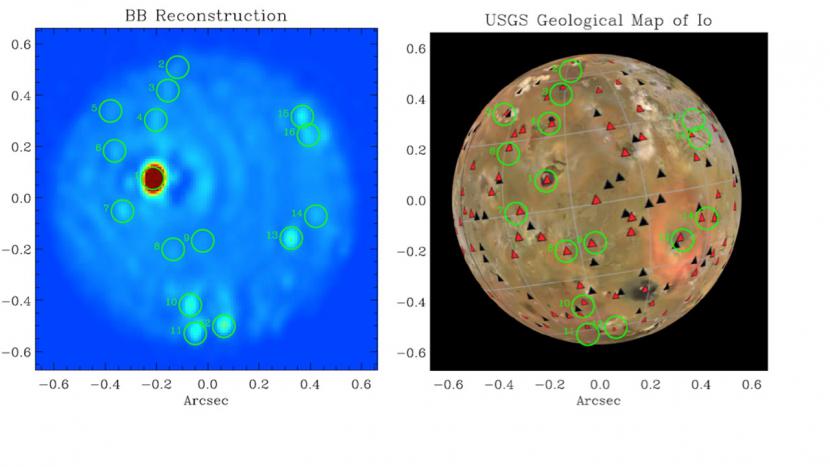-
Jupiter-like exoplanets found in sweet spot in most planetary systems
June 12, 2019
As planets form in the swirling gas and dust around young stars, there seems to be a sweet spot where most of the large, Jupiter-like gas giants congregate, centered around the orbit where Jupiter sits today in our own solar system. The location of this sweet spot is between 3 and 10 times the distance Earth sits from our sun (3-10 astronomical units, or AU). Jupiter is 5.2 AU from our sun. That’s just one of the conclusions of an unprecedented analysis of 300 stars captured by the Gemini Planet Imager, or GPI, a sensitive infrared detector mounted on the 8-meter Gemini South telescope in Chile.
Tags:More -
Giant Telescope Takes a Close Look at a Lava Lake on Jupiter’s Moon Io
May 1, 2015
Scientists recently confirmed information regarding Loki Patera, a volcanic depression on Io (the innermost of Jupiter's four moons) that, up until recently, scientists were unable to closely examine. Using the combined Large Binocular Telescope (LBT) and Large Binocular Telescope Interferometer (LBTI), in addition to the LMIRcam, the camera recording images in the LBTI, scientists found evidence that suggests Loki Patera's bright emissions are actually an active overturning lava lake, a finding that points to confirmations of past hypotheses. From the press release provided by Large Binocular Telescope Observatory: "While we have seen bright emissions – always one unresolved spot – “pop-up” at different locations in Loki Patera over the…
More -
UC Berkeley Astronomers Lead New NASA-Funded Search for Habitable Planets
April 22, 2015
Department of Astronomy faculty member James Graham will lead one of the 16 new projects funded by NASA in efforts to streamline the search for habitable planets. The project is part of the newly announced NExSS (Nexus for Exoplanet System Science) which seeks to bring together "the best and the brightest" to oversee the search. The Berkeley "exoplanets unveiled" project, which will work alongside scientists at Stanford, is unique due to it's involvement of the "Gemini Planet Imager, a new instrument for the Gemini Observatory that began its exoplanet survey in November 2014; GPI has already imaged two previously known exo-planets and disks…
Tags:More -
Astronomers answer key question: How common are habitable planets?
November 4, 2013
NASA’s Kepler space telescope, now crippled and its four-year mission at an end, nevertheless provided enough data to answer its main research question: How many of the 200 billion stars in our galaxy have potentially habitable planets? Based on a statistical analysis of all the Kepler observations, astronomers at UC Berkeley and University of Hawaii, Manoa now estimate that one in five stars like the sun have planets about the size of Earth and a surface temperature conducive to life. Full article can be found here.
More -
Intelligent civilizations rarer than one in a million
February 8, 2013
"Scientists at UC Berkeley have now used the Green Bank Telescope in West Virginia to look for intelligent radio signals from planets around 86 of these stars. While discovering no telltale signs of life, the researchers calculate that fewer than one in a million stars in the Milky Way Galaxy have planetary civilizations advanced enough to transmit beacons we could detect. “We didn’t find ET, but we were able to use this statistical sample to, for the first time, put rather explicit limits on the presence of intelligent civilizations transmitting in the radio band where we searched,” said Andrew Siemion,…
More



